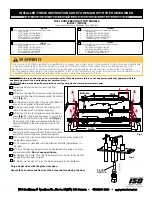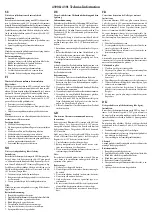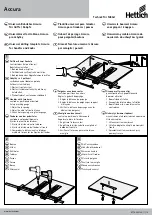
Chamber Loading
The incubator’s chamber temperature stability can be affected by changes in ambient (room) temperature and/or equipment
running in close proximity (crea�ng microclimates) or cycling on the same electrical circuit. Take �me to see how unit loca�on
or changes in room temperature from seasonal hea�ng or air condi�oning may influence the incubator's set temperature.
For
best chamber temperature stability, keep the ambient temperature stable.
Important Opera�onal Notes:
The unit's minimum opera�ng temperature is largely determined by ambient (room) temperature.
The unit can operate
at 2°C (140E models) and 3°C (180E models) above room temperature but temperature stability will be degraded.
The unit’s stability improves appreciably for se�ngs that exceed ambient by 4°C or be�er. Also, the lower the ambient
temperature the lower the minimum adjustable opera�ng temperature.
Adjus�ng the opera�onal temperature range of the unit for
non-typical ambient conditions
can be done by performing an
auto-tune to the unit. (see Auto-tune on controllers func�on )
IMPORTANT
FIG. 5
FIG. 7
FIG. 6
PAGE 5
Understanding the unit's light pressure thermal convec�on and "load-effect" are necessary to op�mize unit performance.
Ar�cle or media processing �mes and/or uniformity are largely dependent on load density and posi�oning.
Process the smallest possible load the applica�on or workload will permit. For best processing of small mul�ples or a single
item, adjust one shelf so that the ar�cle(s) is centered in the incubator.
Avoid placing ar�cles or media against or within an inch of the walls especially on the lower shelf. Heated air from the
lower heat-shield, is designed to travel up the sidewalls and can have a slightly elevated temperature from setpoint and the
rest of the chamber.
Avoid the use of large solid trays or foil on lower shelves, this can dras�cally limit heat to shelves and ar�cles placed above.
Important guidelines to chamber loading and processing:
Load the incubator so that air circula�on within the chamber is not impaired.
Avoid extremely large (in quan�ty or size), or high-density loads
( FIG. 6 ).
This will show by non-uniform processing and long
or impossible "heat-through" �mes. To help determine a large load's suitability, use the set-point recovery �me (the �me it
takes for the temperature to recover to the original set temperature once load is placed), as a guide.
Leave a space between
ar�cles on the shelf.
It is important to note that large trays placed on lower shelves prevent enough heat to rise within the chamber.
(FIG. 7 )
IMPORTANT:
To reduce recovery �me, reduce load propor�onally. Also, large loads such as a beaker containing 2 liters of a solu�on may
require an elevated set temperature for the solu�on to reach and maintain a lower target temperature. When possible,
measure large loads or solu�on temperatures directly with an ancillary thermometer or probe.
Probes can be inserted at
the top port.
Stagger ar�cles from those on lower shelves in a "V" forma�on.
(FIG. 5 )
























